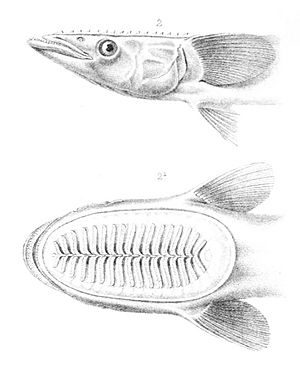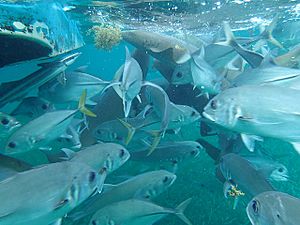Echeneis neucratoides facts for kids
The whitefin sharksucker (Echeneis neucratoides), also called the short-disk sharksucker, is a special type of fish called a remora. It lives in the warm, subtropical waters of the western Atlantic Ocean, the Gulf of Mexico, and the Caribbean Sea. This fish can grow up to about 75 centimeters (30 inches) long, but most are around 50 centimeters (20 inches). Whitefin sharksuckers can swim freely, but they often attach themselves to bigger animals like sharks, other large fish, or even sea turtles. They do this using a special suction cup on top of their heads!
Quick facts for kids Echeneis neucratoides |
|
|---|---|
 |
|
| Head seen from side and from above | |
| Conservation status | |
| Scientific classification |
Contents
What Does It Look Like?
The whitefin sharksucker is a thin, sleek fish. It can grow up to about 75 centimeters (30 inches) long. It has small, sharp teeth in its jaws. It also has teeth on other parts of its mouth, like the vomer and palate.
Its Special Sucker
On top of its head, this fish has a large, oval-shaped sucker. This sucker is actually a changed front dorsal fin. The fish uses it to stick to its host animal. This sucker has between 18 and 22 special ridges called lamellae. A close relative, the Echeneis naucrates, has more of these ridges (23 to 28).
Fins and Color
The whitefin sharksucker's pelvic fins have narrow bases. Its pectoral fins are a bit pointy and have 22 rays. The back dorsal fin has 32 to 41 rays, and the anal fin has 30 to 38 rays.
The top part of the fish is dark brown to black. It also has a wide, dark stripe along its side. This stripe goes from its eye, past its pectoral fin, all the way to its tail. The rest of the fish is silvery-grey. Its dorsal, pectoral, and tail fins are dark. They have whitish edges, especially at the front.

Where Does It Live?
This fish lives in the warm waters of the western Atlantic Ocean. You can find it in the Caribbean Sea and the Gulf of Mexico. Its home range stretches from Massachusetts down to the northern coast of South America. This includes places like the Bahamas and the Antilles. It often hangs around coral reefs. However, it can also be found further out in the open ocean.
How Does It Live?
The whitefin sharksucker sometimes swims by itself. But often, it uses its sucker to attach to a host animal. These hosts can be sharks, other big fish, or even sea turtles. Remoras often eat leftover food scraps that their hosts drop. They might also eat tiny copepods, which are small parasites found on the host's skin.
What Is Its Status?
Scientists are still studying the whitefin sharksucker. They want to learn more about its exact species type. Its home range seems smaller than other remoras. We don't know if its population is growing or shrinking. It doesn't seem to face any big threats right now. Because of these reasons, the International Union for Conservation of Nature has not been able to fully check its conservation status. They have listed it as "data deficient". This means there isn't enough information yet to decide if it's endangered or not.


